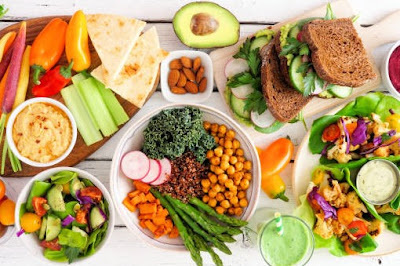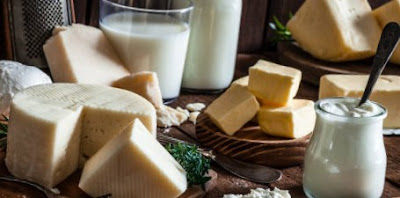Everything You Need To Know About Healthy Foods
A healthy diet consists of the following:
vegetables, fruits, legumes (for example, lentils and peas), dried fruits, and whole grains (for example, unprocessed corn, millet, oats, wheat, and brown rice) dairy product (milk, yogurt, cheese) protein (all types of meat chicken, beef, mutton, and fish).
There are two types of fats. Unsaturated fats and saturated fats (In fish, avocado, and nuts, as well as sunflower, soybean, rapeseed, and olive oils Unsaturated fats are found) should be preferred over while saturated fats (found in fatty meat, butter, palm, and coconut oil, cream, cheese, and clarified butter), and fatty acids of all kinds. There are industrial fatty acids (found in baked and fried foods as well as in snacks and foods, for example, frozen pizzas, pies, cookies, waffles, or cooking oils and spreads), as well as fatty acids from ruminants (found in meat and dairy products from ruminant animals such as cows, sheep, goats, and camels).
 |
| Healthy Foods Or Nutritional Foods |
Healthy Foods Or Nutritional Foods
The total fat intake to less than 30% of reducing fats in total energy intake helps adults avoid gaining too much weight. Steaming or boiling rather than frying food, and limit the consumption of baked and fried foods, as well as snacks and foods (for example donuts, cakes, pies, cookies, and waffles) that contain fatty acids, salt, sodium, and potassium.
Most people get too much sodium from salt intake (an average of 9g to 12g of salt per day), and insufficient potassium intake (less than 3.5g). This contributes to high blood pressure which itself increases the risk of heart disease and stroke.
In many countries, most of the salt comes from processed foods (for example meals, processed meats such as bacon, ham or sausage, cheeses, and snacks) or foods frequently eaten in large quantities. Quantities (ex: bread). Salt is also added during cooking (for example soy sauce, and fish sauce) or at the table salt.
Salt intake can be limited by adopting the following strategies:
Limit the amount of salt and high sodium condiments (ex: soy sauce, fish sauce, and broth) added during cooking and preparing food. The negative effects of high salt intake on blood pressure, by eating fresh fruits and vegetables.
Some Major Groups Of Healthy Foods Are As Under:
- Carbohydrates
- Protein
- Vegetables
- Fruits
- Dairy
- Fats
- Nuts
1. Carbohydrates
Carbohydrates are often termed as such rights which means sugar carbohydrates are mainly classified into three major groups are known as, Monosaccharides, Oligosaccharides, and Polysaccharides, word mono means "one" and these are the simplest types of carbohydrates.
Monosaccharides are the one that has as a functional group examples Aldo's included grosser and glucose Lidos rites are the one, that has as a functional group. For an example of includes fructose all ago said you're right these are the carbohydrates that have to monosaccharides units linked together to form a chain depending on the number of monosaccharides units present.
 |
| Carbohydrates |
2. Protein
Protein is a complex geothermal organic matter composed of molecules of carbon, hydrogen, oxygen, and nitrogen elements. In addition to these elements, some proteins also contain partially zinc, copper, and phosphorus. These are the main constituents of protoplasm and are essential for physical growth and various biological functions. According to the chemical composition, proteins are divided into three categories called simple proteins, composite proteins, and derived proteins. Simple proteins are formed only by amino acids and molecules of some other substances are also combined with amino acids in the formation of composite proteins. Derived proteins are proteins that are obtained from the decomposition of simple or combined proteins. The primary form, the secondary form, the tertiary form, and the quaternary form are the four major forms of protein.
 |
| Protein |
Plants synthesized the amino acids they need on their own, but animals have to take some amino acids from outside as food to meet their protein needs. Among the vegetarian sources are gram, pea, lentil, soybean, kidney bean, wheat, maize. Meat, fish, eggs, milk, and liver are good non-vegetarian sources of protein. Soybeans contain the highest amount of protein in plant foods. It contains more than 40 percent protein. Boys in the age group of sixteen to eighteen years, who weigh 57 kilograms, need 78 grams of protein per day.
3. Vegetables
There are many types of vegetables in your daily diet, from potatoes to caramel. Because the properties of these vegetables not only nourish you but also heal you. Vegetables are easy to digest, easy to cook, with cilantro, chili, and salt. Losing ‘Our Gaining Weight’, we don’t know how to not gain weight even if we don’t eat anything. No matter how much medicine I take, my body does not move. 'I hear one or more such things from the mouths of five to ten patients a day.
If you decide to lose weight, there is a solution. There is a simple solution. But it must be done. Eat a lot of vegetables in your daily routine. The benefits of eating vegetables affect your health. vegetables are one of the most under Sun foods in existence especially when it comes to the standard. Vegetables are high in vitamins. Vegetables are also high in vitamins which are helpful in fighting infection and keeping the body healthy.
 |
| Vegetables are high in vitamins |
4. Fruits
The most nutritious fruit is mango one of the most popular nutritionally rich fruits with a unique taste, flavor, and heath-promoting qualities super most widely consumed fruit in the world. Many people complain of fatigue and weakness. When 100 ml of water remains, drink warm milk mixed with it. It removes physical and mental weaknesses.
About pomegranate Doctors also ask the patient to eat pomegranate to remove weakness or after recovery after treatment. Pomegranate has been described as a very miraculous fruit, as well as it has been told that many diseases can be cured by its consumption.
 |
| Fruits |
Orange around citrus fruits with finely-textured skins that are orange thick. Oranges usually range from approximately 2 to 3 inches in diameter delicious and juicy.
5. Dairy
Dairy is basically defined as any product that contains or is made from animal milk and that isn't just limited to food let's start with eggs often get lumped in with dairy because they're a popular animal product, and they're avoided by vegans, but eggs aren't technically dairy products as they have nothing to do with milk. They're made by birds not mammals they also don't contain any lactose so if you're looking for a dairy-free life and eggs can stay on the menu, but while eggs don't count as dairy your moisturizer might there's been a growing trend of using goat's milk in the beauty industry.
 |
| Dairy |
Dairy Products
Protein powders can come in a wide variety of forms including beef protein egg protein and even P protein perhaps the most common though is whey protein which is derived from a waste product in the manufacture of cheese is of course a dairy product thankfully there are plenty of non-dairy alternatives these days, so you have options.
6. Fats
The four major types of fats foods that are healthy or unhealthy. Fats have different subtypes monosaturated fats polyunsaturated fats. Triglycerides consist of glycerol and fatty acid. Fatty acids chains are made up of carbon atoms and hydrogen atoms. Fats are healthy and unhealthy.
 |
| Fats |
7. Nuts
Nuts are seeds legumes droops or truly botanical nuts. There are also culinary nuts and botanical nuts confused yet, while the definition of a nut botanically speaking a true nut is a hard-shelled pod that contains both the seed and fruits of the plant where the fruit does not open and releases the seed.
Some well-known legumes include peas, beans, and lentils, however, peanuts are also the booms that are classified as both a grain legume because of their high oil content and the small propagate of parts of a plant enclosed in a protective outer covering.
 |
| Nuts |



.png)


.png)

.png)


Nice article
ReplyDelete